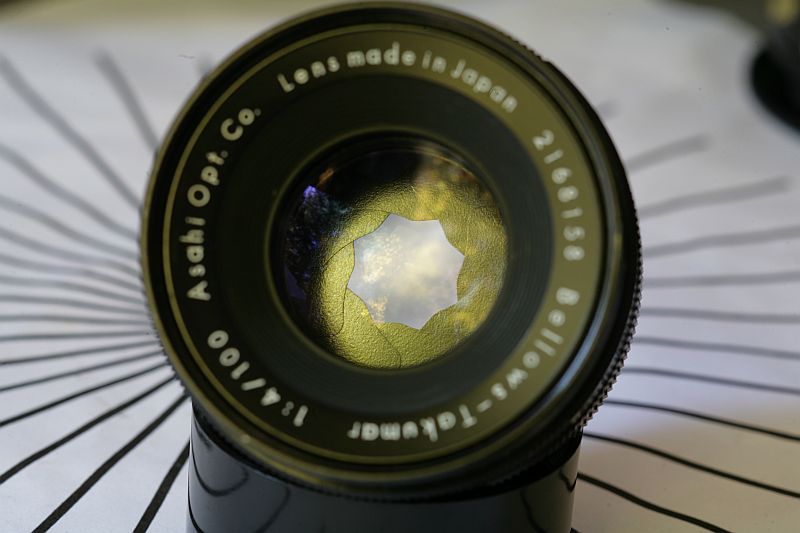| View previous topic :: View next topic |
| Author |
Message |
FotoPete


Joined: 20 Nov 2012
Posts: 126
|
 Posted: Mon Feb 03, 2014 5:36 pm Post subject: Posted: Mon Feb 03, 2014 5:36 pm Post subject: |
 |
|
FotoPete wrote:

Don't forget about the Helios 40! 
_________________
My Gear and Other Ramblings :: http://filmlensaddict.blogspot.ca/ |
|
| Back to top |
|
 |
vanylapep


Joined: 03 Jan 2014
Posts: 312
|
 Posted: Mon Feb 03, 2014 9:37 pm Post subject: Posted: Mon Feb 03, 2014 9:37 pm Post subject: |
 |
|
vanylapep wrote:
Konica Hexanon 40mm f1.8
 |
|
| Back to top |
|
 |
Pontus


Joined: 18 Dec 2011
Posts: 1471
Location: Jakobstad, Finland
Expire: 2016-08-25
|
 Posted: Mon Feb 03, 2014 9:46 pm Post subject: Posted: Mon Feb 03, 2014 9:46 pm Post subject: |
 |
|
Pontus wrote:
Contax Zeiss S-Planar 60/2.8
_________________
Follow this link for my FOR SALE list (partially updated 19.11.2015) |
|
| Back to top |
|
 |
Arkku


Joined: 28 Feb 2007
Posts: 1416
Location: Helsinki, Finland
|
 Posted: Mon Feb 03, 2014 10:45 pm Post subject: Posted: Mon Feb 03, 2014 10:45 pm Post subject: |
 |
|
Arkku wrote:
Volna-9 examples:

 |
|
| Back to top |
|
 |
thebbm


Joined: 11 Dec 2013
Posts: 295
Location: France montpellier
|
 Posted: Mon Feb 03, 2014 10:48 pm Post subject: Posted: Mon Feb 03, 2014 10:48 pm Post subject: |
 |
|
thebbm wrote:
Unfortunately for me Contax yashica carl zeiss distagon 35mm 1.4 and planar 85mm 1.4


[/url] |
|
| Back to top |
|
 |
Rick1779


Joined: 17 May 2013
Posts: 1207
Location: Italy
Expire: 2014-06-06
|
 Posted: Mon Feb 03, 2014 10:59 pm Post subject: Posted: Mon Feb 03, 2014 10:59 pm Post subject: |
 |
|
Rick1779 wrote:
Industar 62 L/D

_________________
TELLTALE
 |
|
| Back to top |
|
 |
Davichin

Joined: 15 Jan 2014
Posts: 33
Location: Canary Islands
|
 Posted: Mon Feb 03, 2014 11:06 pm Post subject: Posted: Mon Feb 03, 2014 11:06 pm Post subject: |
 |
|
Davichin wrote:
Great examples! More lenses to look for...  I will start with the Volna... I will start with the Volna...
_________________
http://www.flickr.com/photos/67522368@N00/
www.davidbarrio.com |
|
| Back to top |
|
 |
kuuan


Joined: 14 Jan 2008
Posts: 4572
Location: right now: Austria
Expire: 2014-12-26
|
 Posted: Tue Feb 04, 2014 5:09 am Post subject: Posted: Tue Feb 04, 2014 5:09 am Post subject: |
 |
|
kuuan wrote:
Canon LTM f1.8/50mm ver.II,
8 blades, looks pretty much the same as those of the Bellows Takumar shown
_________________
my photos on flickr: https://www.flickr.com/photos/kuuan/collections |
|
| Back to top |
|
 |
Nordentro


Joined: 24 Jun 2010
Posts: 4713
Location: Lillehammer, Norway
Expire: 2015-01-29
|
 Posted: Tue Feb 04, 2014 9:32 am Post subject: Posted: Tue Feb 04, 2014 9:32 am Post subject: |
 |
|
Nordentro wrote:
Volna 9 again 

_________________
Lars | Manuellfokus.no |
|
| Back to top |
|
 |
thebbm


Joined: 11 Dec 2013
Posts: 295
Location: France montpellier
|
 Posted: Tue Feb 04, 2014 9:35 am Post subject: Posted: Tue Feb 04, 2014 9:35 am Post subject: |
 |
|
thebbm wrote:
i always asked myself why they build lenses with only few blades like this ?? i think lens constructor can easly put one or two blades to avoid this "star-shaped" apertures.
Anyone know why please ?
thanks |
|
| Back to top |
|
 |
Basilisk

Joined: 21 Mar 2013
Posts: 356
Location: UK
|
 Posted: Tue Feb 04, 2014 10:55 am Post subject: Posted: Tue Feb 04, 2014 10:55 am Post subject: |
 |
|
Basilisk wrote:
| thebbm wrote: |
i always asked myself why they build lenses with only few blades like this ?? i think lens constructor can easly put one or two blades to avoid this "star-shaped" apertures.
Anyone know why please ?
thanks |
In an automatic lens, the blades have to close and open rapidly when the photo is taken, so out went the preset lenses with 16 blades to be replaced with mechanically simpler designs with 6 or so blades. Fewer blades means less friction and less danger of mechanical disfunction. More expensive lenses could be made with higher precision and testing, so could get away with more blades.
At least that is my understanding, which could be wrong. |
|
| Back to top |
|
 |
Davichin

Joined: 15 Jan 2014
Posts: 33
Location: Canary Islands
|
 Posted: Wed Feb 05, 2014 8:24 am Post subject: Posted: Wed Feb 05, 2014 8:24 am Post subject: |
 |
|
Davichin wrote:
Komura 135 3.5 also has a star shaped bokeh...
_________________
http://www.flickr.com/photos/67522368@N00/
www.davidbarrio.com |
|
| Back to top |
|
 |
ZoneV

Joined: 09 Nov 2009
Posts: 1633
Location: Germany
Expire: 2011-12-02
|
 Posted: Wed Feb 05, 2014 9:02 am Post subject: Posted: Wed Feb 05, 2014 9:02 am Post subject: |
 |
|
ZoneV wrote:
| kds315* wrote: |
Does that get visible in the bokeh these lenses produce?
.. |
For sure!
The aperture form results in bokeh form. Sometimes is is softend, for example due to spherical aberration - so the form is no more visible. But in extra bokeh tests and many images with pronouced bokeh one can see the bokeh form.
With an inverse bullseye filter in the aperture position one gets very smooth bokeh - apodization filtering.
The bokeh result is the reason I don�t like the Zeiss Contax AE lenses that much, I think they all have at some f-stops the ninja stars formed aperture.
Zeiss MM lenses not.
The famous Tokina 90mm f/2.5 macro has ninja stars at several f-stops, the Vivitar 90/2.5 predecessor only at one f-stop when I remember correct - this is why I love my Vivitar.
_________________
Camera modification, repair and DIY - some links to look through: http://www.4photos.de/camera-diy/index-en.html
I AM A LENS NERD!
Epis, Elmaron, Emerald, Ernostar, Helioplan and Heidosmat.
Epiotar, Kameraobjektiv, Anastigmat, Epis, Meganast, Magnagon, Quinar, Culmigon, Novotrinast, Novflexar, Colorplan, Sekor, Kinon, Talon, Telemegor, Xenon, Xenar, Ultra, Ultra Star. Tessar, Janar, Visionar, Kiptar, Kipronar and Rotelar.
|
|
| Back to top |
|
 |
Arkku


Joined: 28 Feb 2007
Posts: 1416
Location: Helsinki, Finland
|
 Posted: Wed Feb 05, 2014 9:19 am Post subject: Posted: Wed Feb 05, 2014 9:19 am Post subject: |
 |
|
Arkku wrote:
| thebbm wrote: |
i always asked myself why they build lenses with only few blades like this ?? i think lens constructor can easly put one or two blades to avoid this "star-shaped" apertures.
Anyone know why please ?
thanks |
While I don't know the specific answer as to why they make a star-shaped aperture, I'd like to point out that, e.g., the Volna-9 has six blades, which is the same number as many other lenses (perhaps the most common number of blades in vintage auto-aperture lenses!) but most of them have those six blades arranged as to give hexagon rather than star shape�
So I might speculate that the star shape is actually deliberate, and in being a more complex shape than the more common hexagon, perhaps it is actually an attempt to make the bokeh look better with the same number of blades. |
|
| Back to top |
|
 |
thebbm


Joined: 11 Dec 2013
Posts: 295
Location: France montpellier
|
 Posted: Wed Feb 05, 2014 9:30 am Post subject: Posted: Wed Feb 05, 2014 9:30 am Post subject: |
 |
|
thebbm wrote:
@Basilisk and @Arkku, thanks for the answer.
Maybe that this shape make a better bokey yes.
I just look at a contax 35mm 1.4 and 85mm 1.4 and both have in fact 8 blades but make the "star" shape so it's wanted.
Maybe this is because they're not much space inside the lens to put longer shape ? |
|
| Back to top |
|
 |
ZoneV

Joined: 09 Nov 2009
Posts: 1633
Location: Germany
Expire: 2011-12-02
|
 Posted: Wed Feb 05, 2014 9:35 am Post subject: Posted: Wed Feb 05, 2014 9:35 am Post subject: |
 |
|
ZoneV wrote:
Another reason for the aperture form could be the resulting stars at nighttime photography - not bokeh but the stars around small sharp focussed lights.
_________________
Camera modification, repair and DIY - some links to look through: http://www.4photos.de/camera-diy/index-en.html
I AM A LENS NERD!
Epis, Elmaron, Emerald, Ernostar, Helioplan and Heidosmat.
Epiotar, Kameraobjektiv, Anastigmat, Epis, Meganast, Magnagon, Quinar, Culmigon, Novotrinast, Novflexar, Colorplan, Sekor, Kinon, Talon, Telemegor, Xenon, Xenar, Ultra, Ultra Star. Tessar, Janar, Visionar, Kiptar, Kipronar and Rotelar.
|
|
| Back to top |
|
 |
calvin83


Joined: 12 Apr 2009
Posts: 7553
Location: Hong Kong
|
 Posted: Wed Feb 05, 2014 11:01 am Post subject: Posted: Wed Feb 05, 2014 11:01 am Post subject: |
 |
|
calvin83 wrote:
It is possible that the aperture blade will be more durable/long lasting if they are in such shape...
_________________
https://lensfever.com/
https://www.instagram.com/_lens_fever/
The best lens is the one you have with you. |
|
| Back to top |
|
 |
anscochrome


Joined: 23 Dec 2010
Posts: 115
Location: Omaha, NE
|
 Posted: Fri Feb 07, 2014 5:05 pm Post subject: Posted: Fri Feb 07, 2014 5:05 pm Post subject: |
 |
|
anscochrome wrote:
Contax/Yashica 135mm F 2.8 Sonnar has ninja star diaphragm from 3.2-F 4.0, then it goes away:) |
|
| Back to top |
|
 |
kuuan


Joined: 14 Jan 2008
Posts: 4572
Location: right now: Austria
Expire: 2014-12-26
|
 Posted: Sat Feb 08, 2014 6:48 am Post subject: Posted: Sat Feb 08, 2014 6:48 am Post subject: |
 |
|
kuuan wrote:
I am amazed by the samples shown, very, very creative use of the stars!
just found out that not only Canon LTM 1.8/50 II I mentioned already has the star aperture but also Canon LTM f1.8/35. Wonder if there is quite a number of Canon LTM lenses that have it
_________________
my photos on flickr: https://www.flickr.com/photos/kuuan/collections |
|
| Back to top |
|
 |
RokkorDoctor


Joined: 27 Nov 2021
Posts: 1267
Location: Kent, UK
|
 Posted: Mon Apr 18, 2022 7:22 pm Post subject: Posted: Mon Apr 18, 2022 7:22 pm Post subject: |
 |
|
RokkorDoctor wrote:
| visualopsins wrote: |
Three of the Asahi Pentax lenses have this star-shaped diaphragm from ~f/5.6-11 -- the first M42 version of the Macro-Takumar and the two M42 Bellows-Takumars.
Versions with the star-shape diaphragm:
Macro-Takumar 1:4 50mm 1:1 (M42)
Bellows-Takumar 1:4 100mm (M42)
S-M-C Bellows-Takumar 1:4 100mm (M42)
These versions DO NOT have the star-shaped diaphragm:
S-M-C Macro-Takumar 1:4 50mm 1:2 (M42)
S-M-C Macro-Takumar 1:4 100mm (M42)
SMC Bellows-Takumar (K)
(ref: my lens collection  ) )

f/8 |
I just got an S-M-C Bellows-Takumar 1:4 100mm (M42) which indeed has that 8-pointed star aperture at f/8.
Pentax, like other makers, were perfectly capable of making a rounded or octagonal 8-blade aperture when they designed this lens, so one has to assume it is deliberate.
Best reason I can think of (since I have seen a few other macro & bellows lenses mentioned with star-shaped apertures), is that for this lens it has something to do with controlling the appearance of diffraction softening.
The anticipated use for this macro bellows lens would likely be at magnification ratios of 1:1 or even a bit larger. The most star-shaped aperture is located at f/8 on this lens, which under extension for 1:1 magnification or beyond would translate into an f/16 to f/22 equivalent, which is precisely when diffraction is setting in for the 35mm image format. The aperture shape and number of blades is known to affect the diffraction pattern, with longer opposing parallel straight edges leading to the most pronounced directional spreading (noticeable as the sun-stars at f/16 and beyond). It looks like this aperture is designed to avoid longer opposing parallel straight edges precisely at the likely optimum aperture used for trade-of between DOF and diffraction softening. This is a wild guess, but I think the aperture for this lens has been designed to give a less intrusive appearance of the diffraction softening at the most likely used magnification ratios and aperture setting. I suspect mechanical limitations prevent the aperture to be designed as star-shaped for all apertures, hence it becomes octagonal and eventually round for smaller apertures.
My older Minolta MACRO-ROKKOR 50/3.5 preset lens also has this type of star-shaped aperture precisely at f/8, albeit a bit less pronounced. That lens was also likely to be used on a bellows for magnifications of 1:1 and higher (possibly in reverse), thus f/8 would also translate in a diffraction limiting f/16 or f/22 stop under those use conditions.
It would be interesting to see what the diffraction pattern looks like in particular for a star-shaped aperture like this as opposed to a hexagonal/octagonal/round one of the same size.
_________________
Mark
SONY A7S, A7RII + dust-sealed modded Novoflex/Fotodiox/Rayqual MD-NEX adapters
Minolta SR-1, SRT-101/303, XD7/XD11, XGM, X700
Bronica SQAi
Ricoh GX100
Minolta majority of all Rokkor SR/AR/MC/MD models made
Sigma 14mm/3.5 for SR mount
Tamron SP 60B 300mm/2.8 (Adaptall)
Samyang T-S 24mm/3.5 (Nikon mount, DIY converted to SR mount)
Schneider-Kreuznach PC-Super-Angulon 28mm/2.8 (SR mount)
Bronica PS 35/40/50/65/80/110/135/150/180/200/250mm |
|
| Back to top |
|
 |
|
|
|
You cannot post new topics in this forum
You cannot reply to topics in this forum
You cannot edit your posts in this forum
You cannot delete your posts in this forum
You cannot vote in polls in this forum
|
